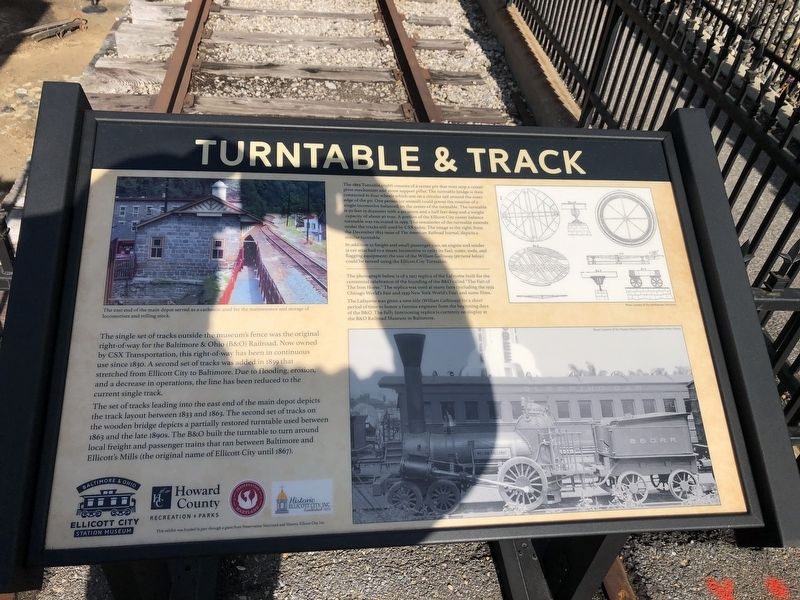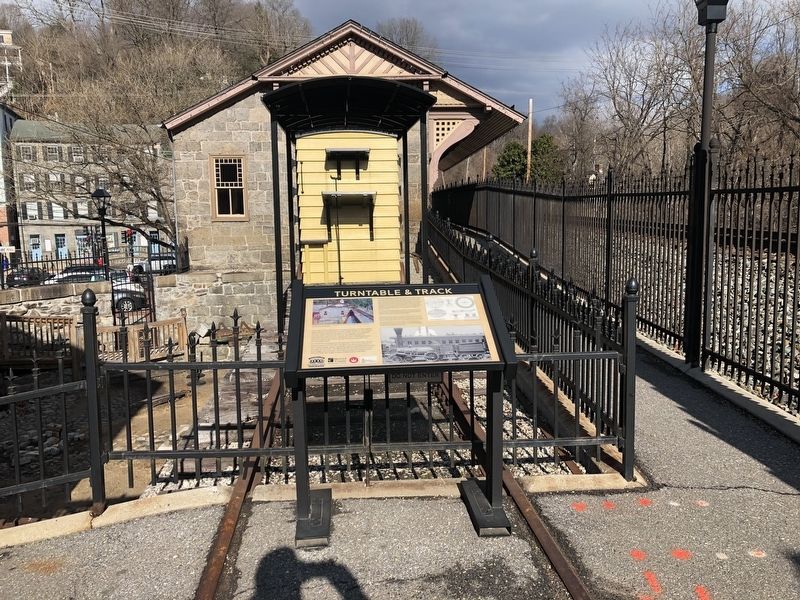Ellicott City in Howard County, Maryland — The American Northeast (Mid-Atlantic)
Turntable & Track
The set of tracks leading into the east end of the main depot depicts the track layout between 1833 and 1863. The second set of tracks on the wooden bridge depicts a partially restored turntable used between 1863 and the late 1890s. The B&O built the turntable to turn around local freights and passenger trains that ran between Baltimore and Ellicott's Mills (the original name of Ellicott City until 1867).
[Captions:]
The 1863 Turntable (right) consists of a center pin that rests atop a center pivot mechanism and stone support pillar. The turntable bridge is then connected to four wheels which rest on a circular rail around the outer edge of the pit. One person (or animal) could power the rotation of a single locomotive balanced on the center of the turntable. The turntable is 50 feet in diameter with a pit seven and a half feet deep and a weight capacity of about 30 tons. A portion of the Ellicott City center balance turntable was excavated in 1999. The remainder of the turntable extends under the tracks still used by CSX today. The image to the fight, from the December 1853 issue of The American Railroad Journal, depicts a similar turntable.
In addition to freight and small passenger cars, an engine and tender (a car attached to a steam locomotive to carry its fuel, water, tools, and flagging equipment) the size of the William Galloway (pictured below) could be turned using the Ellicott City Turntable.
The photograph below is of a 1927 replica of the Lafayette built for the centennial celebration of the founding of the B&O called "The Fair of The Iron Horse." The replica was used at many fairs (including the 1933 Chicago World's Fair and 1939 New York World's Fair) and some films.
The Lafayette was given a new title (William Galloway) for a short period of time to honor a famous engineer from the beginning days of the B&O. The fully functioning replica is currently on display at the B&O Railroad Museum in Baltimore.
Erected by Baltimore & Ohio Station Museum, Ellicott City; Howard County Recreation & Parks; Preservation Maryland; Historic Ellicott City, INc.
Topics and series. This historical marker is listed in this topic list: Railroads & Streetcars
Location. 39° 16.04′ N, 76° 47.694′ W. Marker is in Ellicott City, Maryland, in Howard County. Marker is on Maryland Avenue just south of Main Street (Maryland Route 144), on the left when traveling south. Touch for map. Marker is at or near this postal address: 3711 Maryland Avenue, Ellicott City MD 21043, United States of America. Touch for directions.
Other nearby markers. At least 8 other markers are within walking distance of this marker. The Freight House (a few steps from this marker); To Preserve the Union (within shouting distance of this marker); B&O Railroad Station (within shouting distance of this marker); The Phoenix Emporium (within shouting distance of this marker); Roads versus Rails (within shouting distance of this marker); The Patapsco Hotel (within shouting distance of this marker); Baltimore and Frederick Turnpike Milestone (within shouting distance of this marker); Old Stone Tavern House (within shouting distance of this marker). Touch for a list and map of all markers in Ellicott City.
Related marker. Click here for another marker that is related to this marker. This marker has replaced the linked marker.
Credits. This page was last revised on January 19, 2020. It was originally submitted on January 19, 2020, by Devry Becker Jones of Washington, District of Columbia. This page has been viewed 202 times since then and 19 times this year. Photos: 1, 2. submitted on January 19, 2020, by Devry Becker Jones of Washington, District of Columbia.

